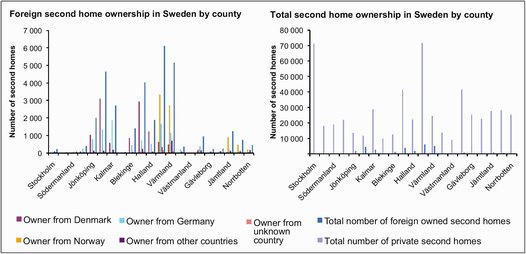Both the use and the ownership of second homes are restricted in Denmark. The construction of new second homes in coastal areas is, moreover, only allowed in exceptional cases while Danish regulations prohibit the use of second homes for other than recreational purposes. They also state that foreign citizens are prohibited from owning second homes in Denmark. This is to ensure access to summer houses for Danes. According to the Danish magazine Business (2004) in spite of this prohibition some 550 foreigners had found ways around these regulations and bought houses.
In Åland one needs to be allotted local citizenship status, or Hembygdsrätt, to be able to own real estate on the island. This right is bestowed only to those who are born in Åland or to those who have a parent who is a citizen. One can also be allocated this right if you are Finnish, speak Swedish and have lived in Åland for the last five years. The Åland government can grant dispensations to foreigners building or buying real estate if the foreigner plans to live permanently there. Hence such dispensations do not apply to foreign second home owners. The regulations are designed to keep the land in Åland in the hands of Ålanders, while also maintaining Åland as a Swedish speaking community.
In Finland and Sweden the acquisition of real estate and natural resources by foreign citizens was tightly controlled before EU accession. This continued during the first five years after accession. Today there are no restrictions in Finland (with the exception of Åland), in Sweden, or for that matter, in Norway.
In Finland calls for the introduction of new regulations have been made in recent years. This is connected to the large number of Russian citizens buying second homes mostly in the eastern part of Finland. In 2008, 70% of all foreigners buying second homes in Finland were from Russia (Ekot 2008, http://sverigesradio.se/sida/artikel.aspx?programid=83&artikel=1947837). In the northern parts of the country the situation is different; skiing resorts attract buyers primarily from Norway.
Norwegians seem, in general, to buy houses abroad to a greater extent than foreigners buy in Norway. Foreign second home ownership is not a 'hot 'topic in Norway according to Evelyn Dyb, research director for Housing and Environmental Planning Research at the Norwegian Institute for Urban and regional Research (NIBR). No regulations exist prohibiting this but in some coastal areas, especially in the south, potential buyers are obliged to move permanently to their new homes. Building or buying in the mountains is restricted to a much lesser extent.
According to Statistics Sweden 5.9%, or more than 33 000 second homes, were owned by foreign citizens in 2009. Many of these estates are located in the southern parts of the country. As shown in the table below, foreign owners can nevertheless be found in the north of the country.
Finding the figures which accurately illustrate second home ownership in the Nordic countries is a problematic exercise. The definition of the term 'second home' is not clear while, in addition, gathering statistics on foreign second home ownership is not, currently, an activity which is often undertaken.

The Journal of Nordregio No 3-2007 had a substantial discussion on developments in second homes in the Nordic countries.